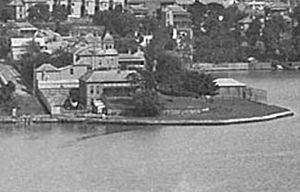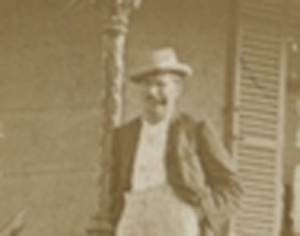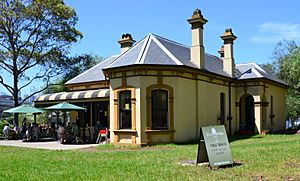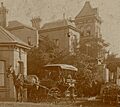Bellevue, Glebe facts for kids
Quick facts for kids Bellevue |
|
|---|---|

Bellevue, Glebe 1899. The large house behind adjoining is Venetia
|
|
| Location | 55–57 Leichhardt Street, Glebe Point, City of Sydney, New South Wales, Australia |
| Built | 1896 |
| Built for | William Jarrett |
| Architect | Ambrose Thornley Junior |
| Architectural style(s) | Victorian Italianate |
| Owner | City of Sydney Council |
| Official name: Bellevue; site of former Venetia (demolished); 55 Leichhardt Street | |
| Type | State heritage (complex / group) |
| Designated | 2 April 1999 |
| Reference no. | 470 |
| Type | Villa |
| Category | Residential buildings (private) |
| Lua error in Module:Location_map at line 420: attempt to index field 'wikibase' (a nil value). | |
Bellevue is a special old house in Glebe Point, a suburb of Sydney, Australia. It used to be a home and then part of a timber yard, but now it's a cafe. It was built in 1896 for a man named William Jarrett. The house was designed by an architect called Ambrose Thornley Junior. Bellevue is important because it's a heritage-listed building, which means it's protected for its history and special design. It's owned by the City of Sydney Council.
History
A Long Time Ago: Indigenous History
Long, long ago, the land around Leichhardt (where Glebe Point is) was home to the Wangal clan of Aboriginal people. They were the first inhabitants of this area. After 1788, when Europeans arrived, many Aboriginal people became sick. They also lost their hunting grounds. This caused their numbers to drop, and they moved further inland.
The areas around Blackwattle Bay and Rozelle Bay have changed a lot over time. They were once residential areas, then industrial, and now they are becoming homes and parks again.
Early European Settlement
The first official land grant in Glebe was given to Rev. Richard Johnson in 1789. He was the colony's first chaplain. This land, called a "Glebe," was meant to support a church minister. It was about 162-hectare (400-acre) of rolling hills and sandstone cliffs.
Creeks like Blackwattle Creek and Johnston Creek flowed through the land. There were also large swampy areas. On the hills, you could find many eucalyptus trees. The swamps had mangroves and blackwattles, which gave Blackwattle Bay its name. Early settlers used to collect wattles and reeds for building. They also hunted kangaroos and emus. They even called the area "Kangaroo Ground."
Johnson's land stayed mostly undeveloped until 1828. Then, the Church and School Corporation divided it into 28 smaller lots. They kept three lots for church use. The Church sold 27 of these lots in 1828. Wealthy people bought land on the point because of the sea breezes. They built large villas there. Closer to Broadway, industries like slaughterhouses were built. Smaller homes for working-class families grew up around these businesses.
Glebe became a municipality (a local government area) in 1859. In the late 1800s, Wentworth Park was created on reclaimed swamp land. It opened in 1882 for sports like cricket and lawn bowls. Dog racing started there in 1932.
In the early 1900s, many large villas in inner Sydney, including Glebe, were turned into boarding houses. Wealthier families moved to new suburbs that were easier to reach by train. By the 1960s, Sydney was changing. It became more about office jobs than factory work. This meant younger professionals wanted to live closer to the city. People also started to care more about saving old buildings.
The Story of Bellevue
Many of the lots near Blackwattle Swamp were bought for dirty industries. These included places for tanning leather or smelting copper. But the higher land to the north, with views of the harbour, became popular for "villa retreats." These were large homes where rich merchants could escape the busy city.
Alexander Brodie Spark bought the land where Bellevue now stands in 1828. He owned a large 8-hectare (20-acre) lot. But in the 1840s, he went bankrupt, and his land was sold. By 1870, Mary Chisolm owned much of the original land. She started dividing it up and selling it in 1873.
William Jarrett and His Homes
In 1873, William Jarrett bought two lots next to the water. He was born in Kent, England, in 1829. He came to Sydney in 1853 with his wife and two daughters. William Jarrett became very successful in real estate. He bought a lot of land and property over 30 years. In Glebe, he owned many houses, including seven heritage-listed homes on Glebe Point Road.
In 1875, Jarrett built a very large house on his land. He called it Venetia. This house was known for being full of art that the Jarretts collected on their travels. William Jarrett was a strict father. His children and their spouses continued to live at Venetia even after they got married.
Venetia was described as a "handsome and commodious two-story brick residence." It had a wide entrance hall, four living rooms, and seven bedrooms. It also had a coach house, stable, and beautiful gardens leading down to the water.
Jarrett's first wife, Margaret, died in 1891. In 1892, he remarried Lucy A. White. Around 1896, Jarrett asked Ambrose Thornley, an architect, to build Bellevue. This new house was built on the land next to Venetia, facing the bay.
Bellevue was described as an "elegant Villa on the Point." It was made of brick with a slate roof. It had a hall, three living rooms, four bedrooms, and lovely gardens. Ambrose Thornley Junior, who designed Bellevue, also designed the Glebe Town Hall.
Jarrett rented out Bellevue from the time it was built. One of the first people to rent it was James George Warden, who took a famous photo of Bellevue in 1899. William Jarrett died in 1901. His second wife, Lucy, lived at Venetia until 1903.
James George Warden, a Tenant
James George Warden rented Bellevue from 1898 to 1903. He was born in London around 1860 and moved to Sydney in 1878. In 1886, he started his own business, Warden Hotel Brokers. He married Mary Jane O’Dwyer and they had five sons and one daughter. Their youngest child was born in Glebe in 1899. James George Warden was also a founding member of the Royal Motor Yacht Club. He died in 1937.
Bellevue Changes Hands
After Jarrett's death, Bellevue and Venetia were sold to a lawyer named William Archibold Windeyer in 1913. By 1915, Venetia was no longer listed, suggesting it was pulled down around that time.
After about 1925, the area around Blackwattle Bay became more industrial. Bellevue became part of a timber yard for many years. By 1970, the foreshore (the land along the water) was very messy. A newspaper called The Glebe described it as a "disaster area" with "deserted timber yards" and "rusting hulks of barges."
The Vanderfield & Reid Ltd. Timber Yards took over the sites of Venetia and Bellevue. They even extended their timber yard into the bay, floating many logs there.
Saving Bellevue in the 1970s
In 1970, the large timber yard was sold to a hardware company. The land was planned to be changed from industrial to residential. This meant new apartments could be built. As part of the deal, the developer agreed to create a park along the foreshore. This happened thanks to local people and groups like the Glebe Society. They especially fought to save Bellevue from being demolished.
The developer was supposed to restore Bellevue for community use. But they started to pull it down by mistake. They stopped the demolition, but they didn't fix the building properly. They also dumped dirt from the apartment construction onto the Bellevue site.
Bellevue in Pop Culture
In 1979, the Australian band Australian Crawl filmed their music video for the song "Beautiful People" at Bellevue. At that time, the house was run-down and covered in graffiti.
Description
Bellevue is built in a style called Italianate. It is made of brick with a stucco (a type of plaster) finish. Part of the house is two stories high. It has a new roof made of fibre cement shingles. It also has a curved verandah. The building has many bedrooms, large areas for entertaining, and several rooms in the basement.
In 2003, Bellevue came under the care of the City of Sydney Council. In 2005, the Council planned to restore Bellevue as part of upgrades to the Glebe foreshore parks. On March 3, 2007, an open day was held to celebrate the building's restoration. The house is still owned by the City of Sydney Council. It was turned into a cafe by 2012, but this cafe closed in 2016. In 2018, there were plans for a new cafe/restaurant to open there.
Current Condition
As of 2004, Bellevue was still in poor condition and fenced off. It has been assessed as having local historical importance. Bellevue and the remains of Venetia show what houses built in the late 1800s were like in the area. The site where Venetia stood is believed to hold many important archaeological clues.
Changes Over Time
- 1875+: Venetia was built. It had several smaller buildings, a boatshed, and formal gardens.
- 1896: Bellevue was built.
- c. 1915: Venetia was pulled down. A large shed was built over its site for timber operations.
- 1925: Timber milling began on the site. The Vanderfield & Reid Timber company used both Bellevue and Venetia's sites. They added buildings to Bellevue, like a shed in the courtyard.
- c. 1970: Many timber-framed buildings were on the site. There was a lot of clearing and dumping of fill (extra dirt) on the land.
- 1970+: Blackwattle Bay Park was created. All buildings except Bellevue were removed. More fill was added, and the area was landscaped with trees and grass.
Heritage Listing
Bellevue was built around 1896 and designed by Ambrose Thornley. It is an example of a late Victorian house with some Italianate features. It is one of the few remaining houses from that time on Jarrett's Point. The house shows the architectural style and how the area developed in the late 1800s. However, many of its original details have been lost.
Bellevue is important to the local area because it's a landmark. It sits in a prominent spot on Jarrett's Point within Blackwattle Bay Park. You can see it from many places, and it's a key part of the Glebe foreshore. Bellevue also has social importance. In the mid-1970s, local residents fought hard to save it from being pulled down by developers.
Bellevue is important for its beauty and its role in the townscape between Rozelle Bay and Blackwattle Bay. It is also architecturally important as one of the most visible cottages at Glebe Point.
Bellevue was added to the New South Wales State Heritage Register on April 2, 1999.
Images for kids





